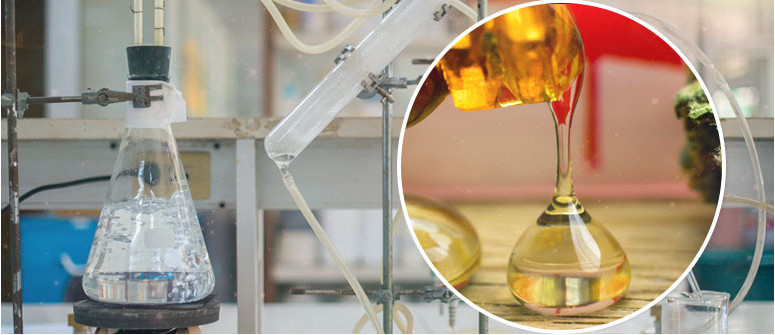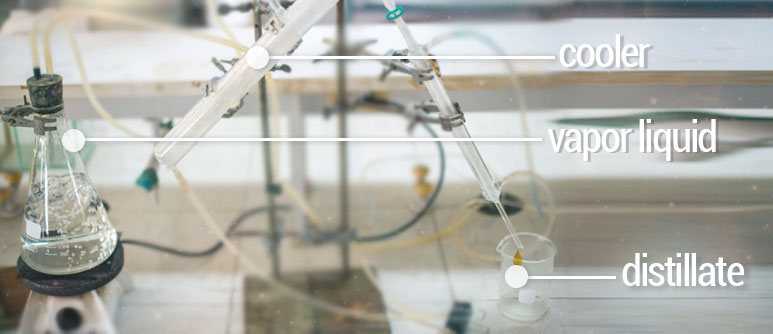What is cannabis distillate?

Cannabis distillate is the new concentrates 2.0. The next level for extracts and oils. Through the process of distillation, an end product with incredible clarity and potency can be made, possibly changing the game for both medicinal and recreational cannabis use.
Innovation is rapidly evolving within the cannabis world and one of the biggest goal in mind seems to be to create the purest and strongest product possible. Cannabis distillate seems to be the next step in the direction of reaching that goal.
The perfect version of a strong and clean product would not only allow recreational users an extremely easy and instant way to obtain the perfect psychoactive high and pleasant stone they desire but also allow medicinal users to instantaneously dose with incredibly effective and potent medicine.
Cannabis products have come a very long way from simply blazing a joint full of dried flowers or hash. Oils, tinctures, and extracts have served as a stepping stone into an entirely evolved cannabis scene, offering innumerable ways to get high and much stronger and effective experiences.
Certain extracts and oils are much more potent nowadays and can achieve ranges between 70-85%, yet still considerably weak in comparison to distillate. Cannabis distillate is the end result of a distillation process that can turn out an end product with strength and purity of up to 99% cannabinoids.
While this potency is absolutely unmatched, caution should also be utilized when planning to ingest it. Even the most seasoned of weed veterans may be given a hard time if they overdo things within this area.
However, a product of this purity can also offer recreational smokers a high that they probably haven’t experienced before, and may offer medicinal users a better chance fighting a whole array of conditions.
A NEW LEVEL OF PURITY
(Video by Christopher Leifson)
Cannabis distillate is very pure. And for very good reasons it has also been given the titled “The Clear” and “The Pure”. Compared to other cannabis extraction techniques, like BHO or CO2, distillate produces a resin that is almost entirely composed of cannabinoids, terpenes, and flavonoids, without any unwanted residue included and therefore much cleaner.
Methods of making shatter, hash, or wax all produce a respectable and potent end result, yet the process involved in their creation almost always lends to slight contamination.
Many rates are made using solvents or butane alongside pressure and rinsing methods. Although effective, these techniques can leave behind unwanted residues that may taint taste and certainly don’t have a place within the body.
The impressive purity of cannabis distillate is achieved via the distillation process, which is the action of purifying a liquid through heating and cooling. Distillation acts to extract the essential oils and compounds from a plant, and in doing so takes what is valuable and desired whilst leaving behind everything else.
In the case of the cannabis plant, cannabinoids, terpenes, and flavonoids are what you want in the end product because of their effects, tastes, aromas, and medicinal value. What is left behind includes waxes, fats, chlorophyll, and various potential contaminants such as heavy metals and pesticides.
HOW DISTILLATION WORKS

Cannabis distillation works by taking advantage of the volatility of the target compounds that exist within the plant. The volatility — or boiling points — of terpenes, flavonoids, and cannabinoids all vary.
This means that they can be extracted into the same end product, or can be precisely separated to create an end product that is almost entirely comprised of either THC or CBD. The distillate can be designed to fulfill various purposes depending on the set goal. The temperature ranges for the more delicate volatiles such as terpenes is around 190°C/374°F, whereas for cannabinoids its around 260°C/500°F.
The distillation process employs heat to vaporize cannabinoids, and a cooling system to condense and separate them. A cannabis extract is placed within glassware, where heat is applied. When the correct temperature is obtained, the cannabinoids are vaporized and rise entering a cooling pipe. The vapor then condenses and drips into a separate glass container that holds the distillate.
This process separates the described cannabinoids from unwanted products, creating an incredibly clear and pure substance.
Because terpenes and other more volatile, yet beneficial compounds have a far lower boiling point, they may be destroyed during this process. However, it is possible to extract these precious compounds separately beforehand and then to add them into the mix after both procedures have been carried out.
DISTILLATION CHANGING THE GAME
The pure and potent nature of cannabis distillate can make the construction of many different cannabis products far easier, and possibly cheaper. Distillate containing only cannabinoids has no flavor and will be extremely easy to add to a range of edibles and beverages, sidestepping any complex and lengthy cooking procedures.
Distillation will also have its place in the health and beauty industries, where it could easily be applied to a wide range of creams, oils, and even bathing products.
Perhaps the most significant and worthwhile change that distillate can bring is the change it might have on the role of cannabis as a medicine.
Up until this process, many patients were limited to extracts and products that had no way near the potency of distillate. Distillate will inevitably become more widespread and will certainly bring relief and effectiveness to many patients needing higher doses of cannabinoids.
A distillate of CBD may be very useful in some cases of medicinal application and an end product containing mostly THC with some beneficial terpenes has been recognized as to be very helpful for pain relief.
ANY DRAWBACKS?
The only real drawback from such pure substances is that messing with content ratios can be a tricky thing.
In a cannabis plant, there is a set amount of all compounds, and they all interact with each other (the so-called “entourage effect”) to produce an effect — this is why different strains have different effects — they have different ratios of cannabinoids, terpenes, and other compounds. When making distillates, it is down to the creator to tailor these ratios.
You could say that the one who makes the distillate gets to mess with nature, and done incorrectly, it could make for a very unpleasant experience. For example, pure THC is said to be a horrible experience without other cannabinoids to regulate and add to the effects.
Distillates give a great deal of control, which will be incomparable in professional hands.
So, wether you are looking to try distillate for medical or recreational purposes, it is therefore very important to know what kind of product you are planning to use and to make sure you know how to moderate the dosages.
.jpg)
.jpg)

.jpg)
